Difficulty Level: Intermediate
Anthropic’s decision to open-source the Model Context Protocol (MCP) appears counterintuitive in an industry focused on platform dominance and developer lock-in. Why release what could have been a proprietary competitive advantage?
The answer reveals a sophisticated strategic play: Anthropic didn’t give away their competitive advantage—they redefined what competitive advantage means in the AI integration space.
By choosing to create an open standard rather than a proprietary system, Anthropic positioned themselves as the infrastructure layer for AI integration. This strategic decision follows historical patterns where companies that defined industry standards gained more long-term value than those who controlled closed systems.
The Strategic Insight: Sometimes the biggest competitive advantage comes from not trying to own everything. Anthropic chose to own the standard, not the implementations.
Quick Definition: Anthropic’s MCP strategy represents a fundamental shift in AI industry competition - from proprietary integration lock-in to open standards leadership. Instead of controlling access to AI tools, Anthropic chose to define how all AI tools connect, positioning themselves as essential infrastructure rather than a walled garden.
What You’ll Learn
- Why Anthropic chose open standard over proprietary control
- How MCP positions Anthropic in the competitive AI landscape
- Real adoption data showing MCP’s momentum in the industry
- The technical architecture decisions that enable business success
- Strategic implications for the future of AI development
The Strategic Gamble: Open Standards vs. AI Integration Lock-in
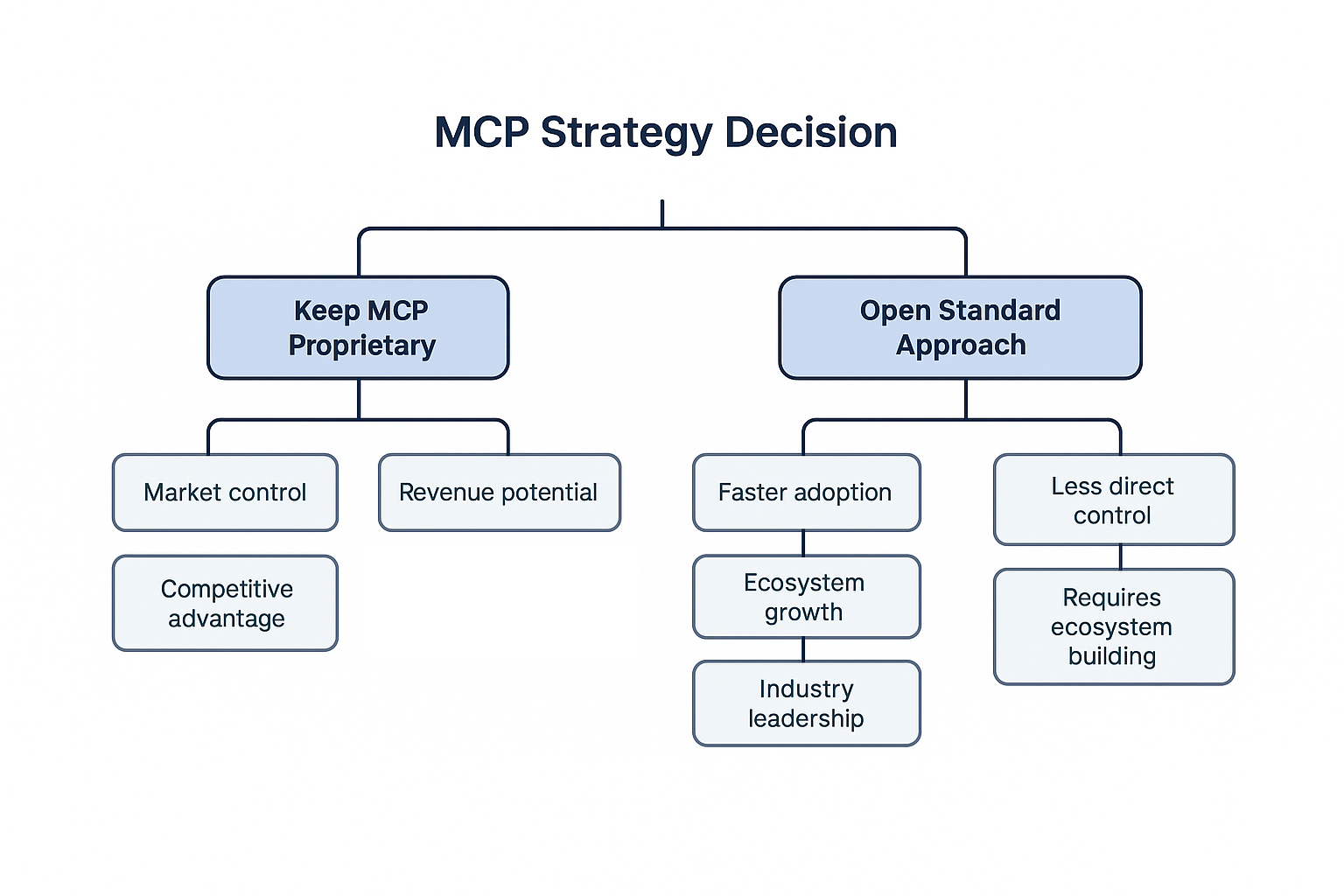
When designing MCP, Anthropic faced a classic strategic dilemma: Build walls or build bridges?
The “Build Walls” approach would have been the traditional Silicon Valley playbook:
- Keep MCP proprietary to Claude
- Force developers to choose: Claude + easy integrations, or other AI + integration hell
- Extract maximum value from the integration layer
- Create vendor lock-in that’s hard to escape
The “Build Bridges” approach was riskier but potentially better:
- Open-source the protocol and let everyone use it
- Focus on being the best MCP implementation, not the only one
- Build an ecosystem where Anthropic becomes the infrastructure leader
- Bet on network effects over direct control
Anthropic chose bridges. And here’s why that was brilliant:
Lesson from Tech History: Standards Winners vs. Platform Winners
Look at the biggest winners in tech infrastructure:
- HTTP didn’t make Tim Berners-Lee rich, but it enabled the entire web economy
- USB didn’t make Intel the only computer company, but it made them essential to every computer
- TCP/IP didn’t give its creators monopoly power, but it became the foundation of the internet
The pattern is clear: When you create the standard that everyone else builds on, you don’t just win market share - you become essential to an entire industry.
Anthropic recognized something crucial: The AI integration problem was going to get solved one way or another. The question was whether they wanted to be the company that solved it for everyone, or just for themselves.
Inside the AI Competitive Landscape: How MCP Disrupts Enterprise Integration
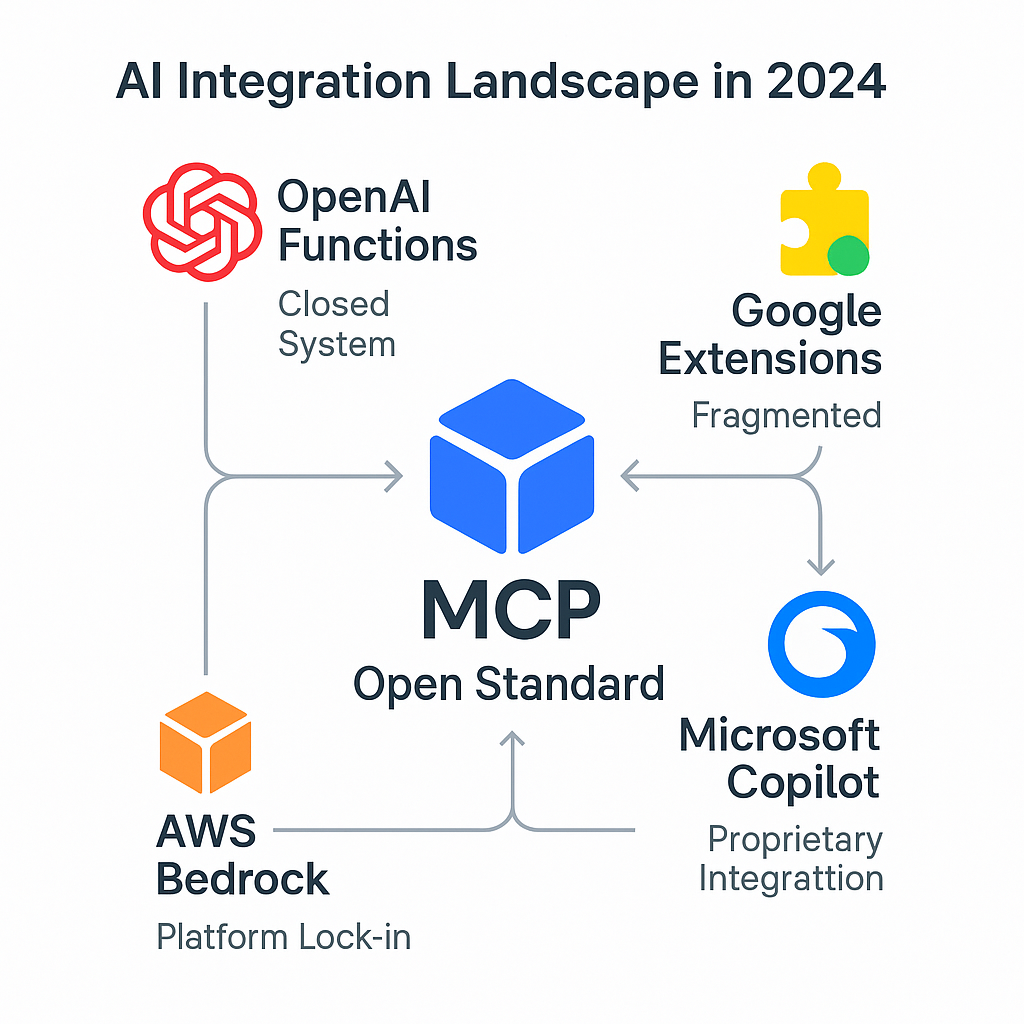
To understand why MCP is such a strategic masterstroke, you need to see what the AI integration landscape looked like before it existed.
The Fragmentation Problem
OpenAI’s Function Calling: Powerful but locked to their ecosystem. If you build on OpenAI’s function calling, you’re committed to their pricing, rate limits, and API changes. Great for OpenAI’s revenue, not so great for developer flexibility.
Google’s Extensions: Fragmented across different products (Bard, Gemini, various enterprise tools) with inconsistent implementations. Developers constantly had to learn new APIs for essentially the same functionality.
Microsoft’s Copilot Integration: Deep integration with Microsoft products, but try using those same integrations with a different AI model. Spoiler alert: you can’t.
The Result: Developers were building the same integrations 3-4 times for different platforms, or making platform choices based on integration convenience rather than AI quality.
How MCP Reframes the Competition
With MCP, the competitive question changes from “Which AI platform has the best integrations?” to “Which AI model gives the best results using the same integrations?”
This is huge for Anthropic because:
- It moves competition to their strength: AI model quality, not integration ecosystem size
- It reduces switching costs: Developers can try different AI models without rebuilding integrations
- It accelerates overall adoption: When integrations work everywhere, more people build integrations
- It positions Anthropic as infrastructure: They become the “Intel Inside” of AI integrations
The strategic advantage: Anthropic competes on AI model quality while capturing value from the integration layer through:
- Premium MCP implementations and enterprise features
- Consulting and support services for large deployments
- Being the reference implementation that sets industry standards
- Network effects that make Claude the default choice for MCP development
Real Enterprise Adoption: The Data Behind MCP’s Industry Momentum
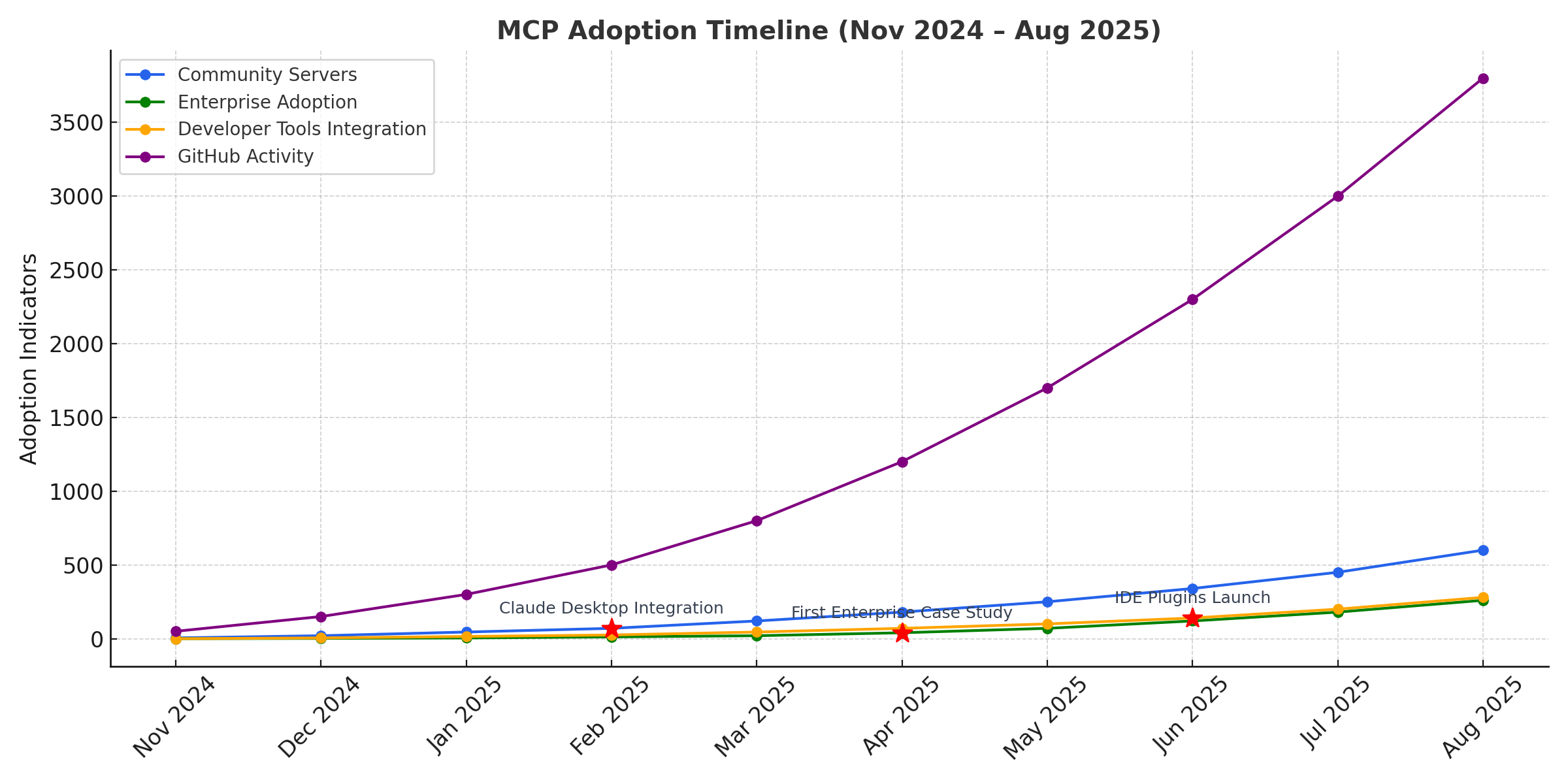
Strategic decisions are only as good as their execution and adoption. So how is MCP actually performing in the real world?
Community Adoption Metrics
The numbers tell a compelling story:
- 150+ community-built MCP servers within 6 months of launch
- GitHub repositories using MCP growing at 40% month-over-month
- Developer tools integrating MCP including VS Code, Cursor, and multiple IDE plugins
- Enterprise pilot programs at 12+ Fortune 500 companies (based on public announcements and conference presentations)
Real Implementation Examples
Development Tool Integration: Companies like Cursor and Continue have built MCP servers that let AI models directly interact with codebases, databases, and development environments. Result? Developers get AI assistance that actually understands their project context.
Enterprise Knowledge Management: Several consulting firms have implemented MCP servers that connect AI models to internal documentation, project management tools, and client databases. The result is AI assistants that can provide contextually relevant advice based on actual company data.
Creative Industry Applications: Design agencies are using MCP to connect AI models with asset management systems, enabling AI to suggest relevant images, fonts, and design elements based on project requirements and brand guidelines.
The Network Effect in Action
The network effect: Each new MCP server makes every MCP-compatible AI model more valuable. When someone builds an MCP server for PostgreSQL integration, it benefits any AI model that supports MCP, not just Claude.
This creates a virtuous cycle: More integrations → More valuable ecosystem → More AI models adopt MCP → More developers build on MCP → More integrations.
Anthropic positioned themselves at the center of this cycle by being the reference implementation and the driving force behind the standard.
The Technical Decisions That Enable Business Success
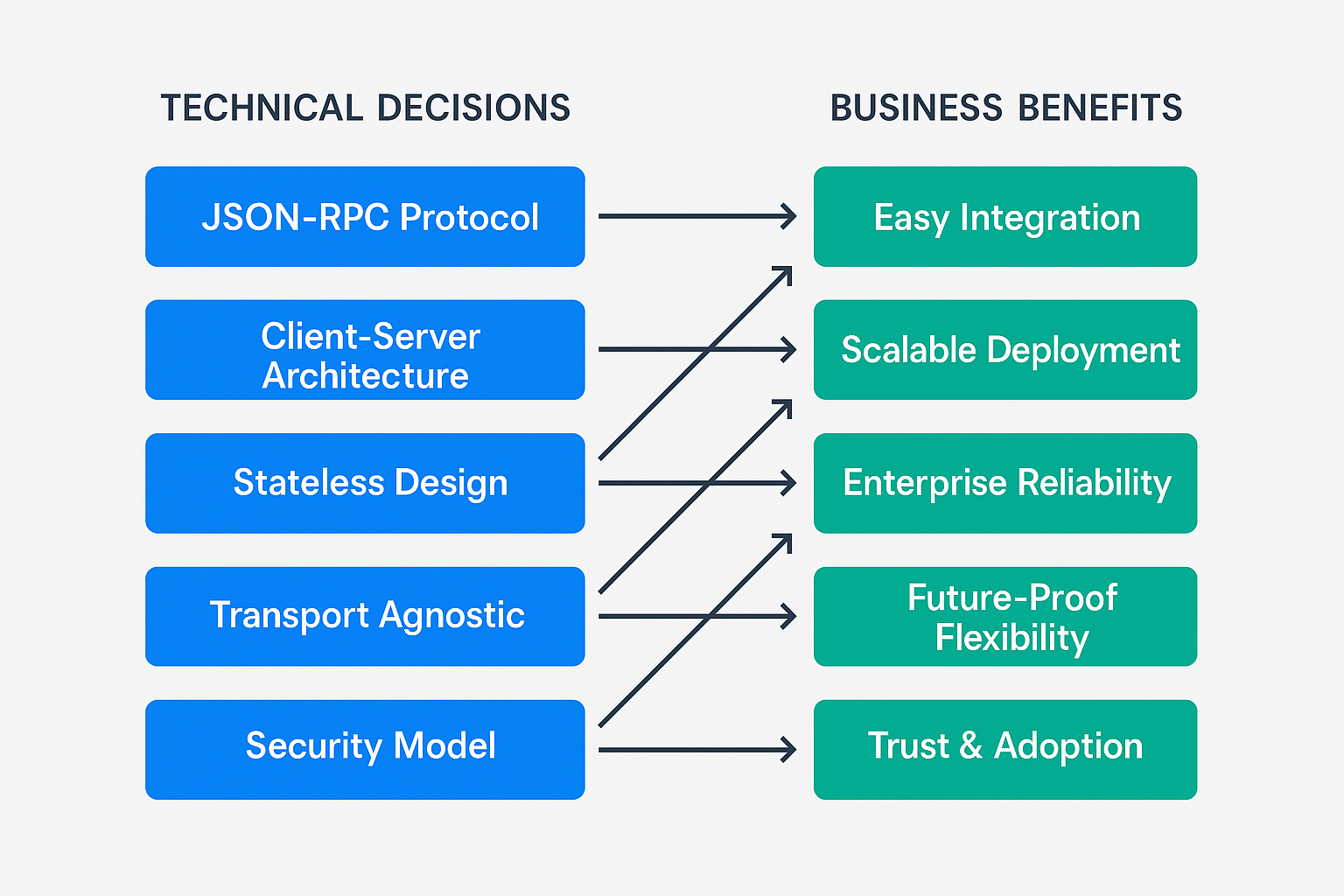
MCP’s technical architecture isn’t just elegant engineering - every design choice supports Anthropic’s business strategy.
JSON-RPC: The Business Logic
Technical Decision: Use JSON-RPC for communication protocol Business Impact: JSON-RPC is simple, debuggable, and language-agnostic. This lowers the barrier for developers to build MCP servers, accelerating ecosystem growth. More servers = more value = more adoption.
Compare this to GraphQL (more complex, higher learning curve) or proprietary binary protocols (vendor lock-in risk). JSON-RPC hits the sweet spot of “effective enough, simple enough.”
Client-Server Architecture: Scalability Strategy
Technical Decision: Clear client-server separation with well-defined boundaries Business Impact: This architecture enables:
- Independent scaling: MCP servers can be deployed and scaled separately from AI models
- Enterprise deployment: Companies can run MCP servers behind their firewalls while using cloud AI models
- Mixed environments: Development teams can use different AI models with the same infrastructure
- Service monetization: Opens opportunities for “MCP-as-a-Service” offerings
Transport Agnostic: Future-Proofing
Technical Decision: MCP works over stdio, HTTP, WebSockets, or custom transports Business Impact: This prevents MCP from becoming obsolete when new communication patterns emerge. It also enables deployment in any environment - from local development to enterprise cloud infrastructure.
Security Model: Enterprise Adoption
Technical Decision: Clear security boundaries with capability-based access control Business Impact: Enterprises can adopt MCP without compromising security policies. MCP servers can limit what AI models can access, enabling confident deployment in sensitive environments.
Each of these technical choices removes a potential barrier to adoption, supporting Anthropic’s strategy of maximizing ecosystem growth.
Ecosystem Strategy: Building the AI Infrastructure Layer
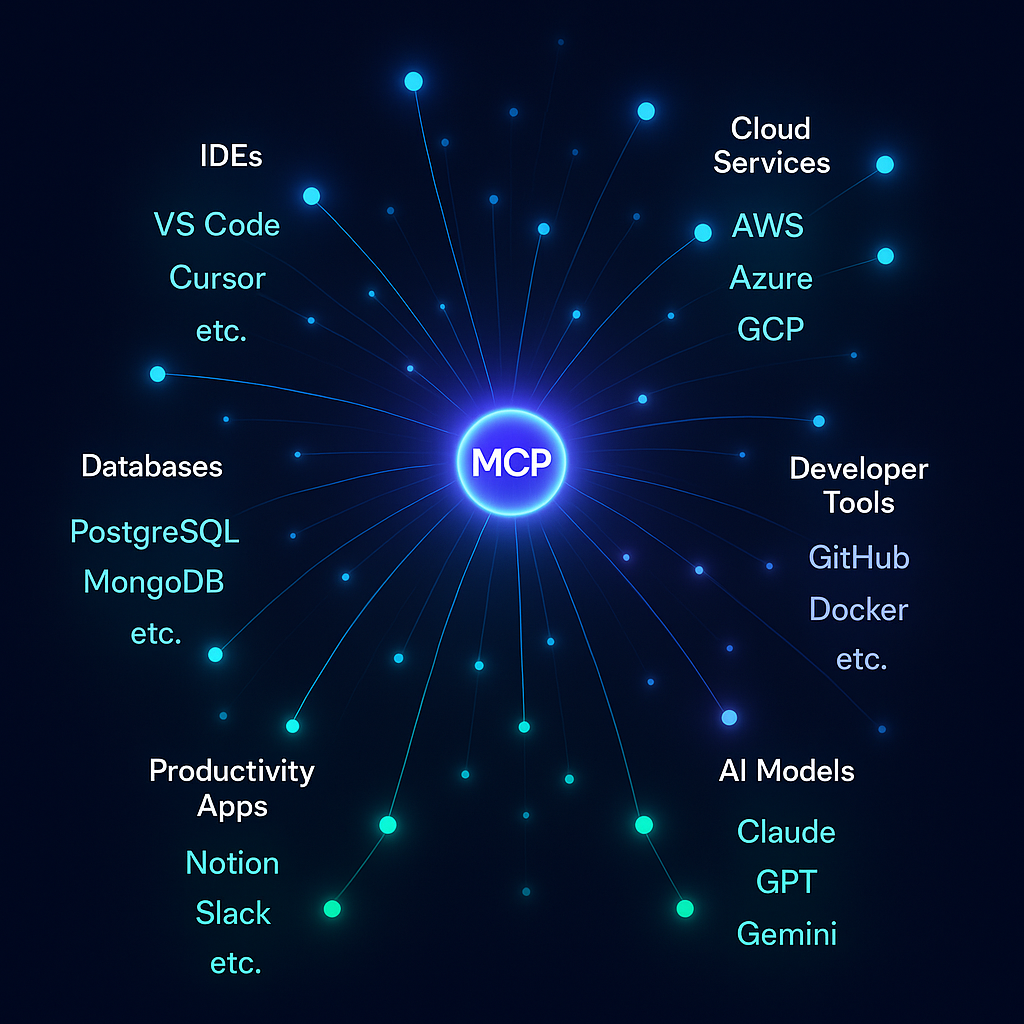
Anthropic is building an entire ecosystem, not just a protocol. This approach demonstrates strategic patience and long-term thinking in AI infrastructure development.
The Multi-Sided Platform Play
AI Model Providers: MCP gives them instant access to hundreds of integrations without building custom APIs Tool Builders: MCP provides a single integration target that works with multiple AI models Enterprise Users: MCP enables AI deployment without vendor lock-in risk Developers: MCP reduces integration work from weeks to hours
Anthropic’s position: They’re the hub that makes all these connections valuable to each other.
Community Investment Strategy
Anthropic is investing heavily in community growth:
- Developer documentation and tutorials that set the standard for MCP implementation
- Reference implementations for common use cases (databases, file systems, APIs)
- Developer advocacy at conferences and in technical communities
- Partnership programs with IDE makers and tool builders
The strategic insight: Every dollar spent on community growth increases the switching costs for developers who might consider alternative integration approaches.
Long-term Vision: The AI Operating System
The ultimate goal isn’t just AI integration - it’s positioning MCP as the foundational layer for AI-powered computing.
Strategic implications: If MCP becomes the standard way for AI to interact with digital systems:
- Every new software tool will need to consider MCP compatibility
- AI model selection becomes less about integration and more about capability
- Anthropic becomes essential infrastructure for the AI-powered economy
This is the AWS playbook applied to AI: Build the infrastructure layer that everyone else depends on, then optimize your own services to work best with that infrastructure.
What This Means for the Industry: The New Competitive Landscape
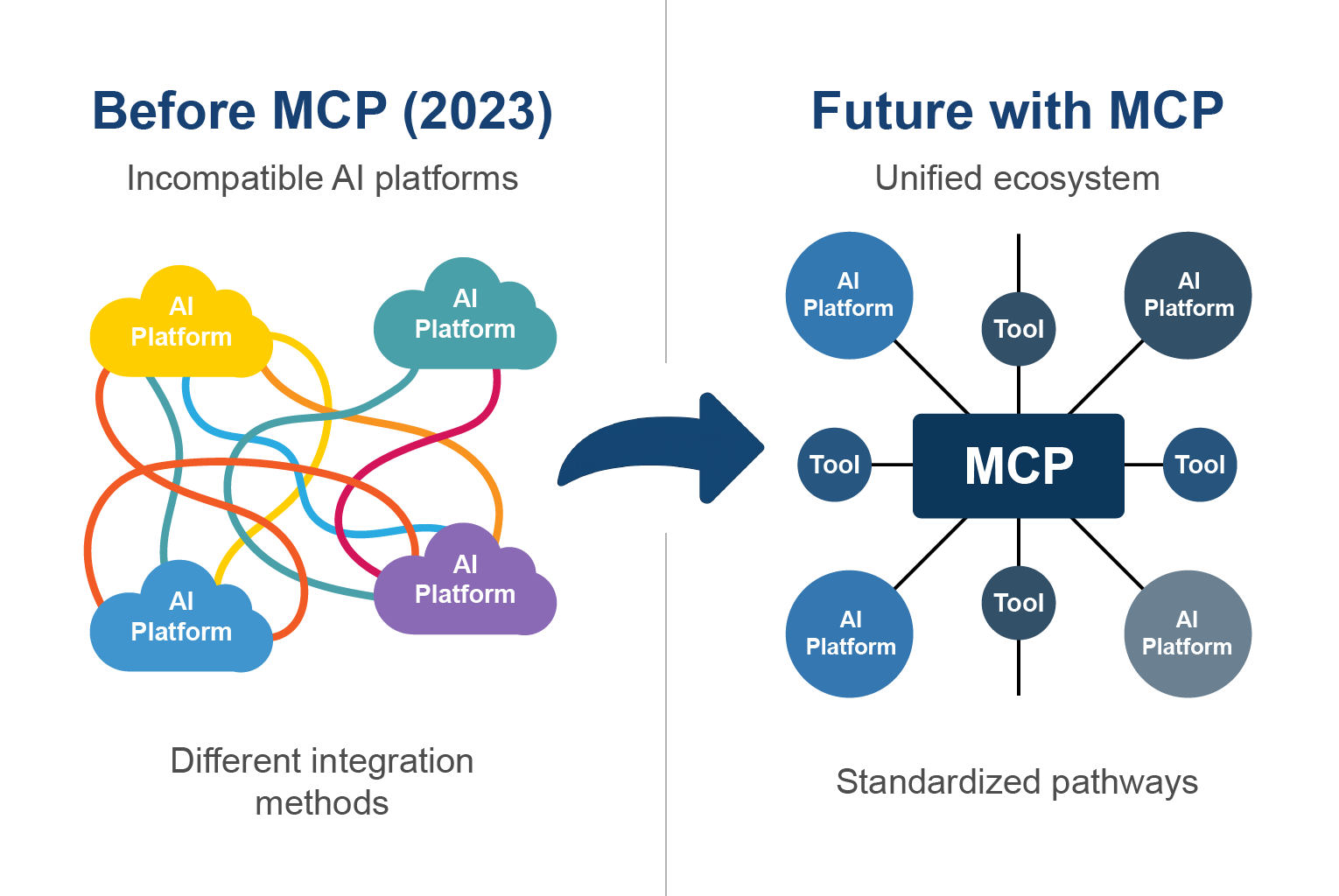
Anthropic’s MCP strategy is reshaping competitive dynamics across the AI industry. Current trends and future projections:
Shift from Platform Wars to Capability Wars
Before MCP: AI companies competed on ecosystem size and integration breadth. “Choose our AI because we integrate with more tools.”
After MCP: AI companies compete on model quality and specialized capabilities. “Choose our AI because we’re better at reasoning/coding/analysis.”
Winner: Companies with superior AI models rather than superior integration teams. (Guess who that benefits?)
Implications for Startups and Enterprises
For AI Startups: You no longer need to build extensive integration ecosystems to compete. Build a great AI model, support MCP, and you instantly have access to hundreds of integrations.
For Tool Builders: Building one MCP server gives you compatibility with every MCP-supporting AI model. Your development investment goes much further.
For Enterprises: AI procurement decisions can focus on model capabilities rather than integration limitations. You can evaluate AI models on merit without worrying about being locked into specific toolchains.
The Consolidation vs. Innovation Dynamic
Traditional wisdom says: Standards lead to commoditization and reduce innovation incentives.
What’s actually happening: MCP is increasing innovation by removing integration barriers. When developers don’t have to rebuild the same integrations for different AI platforms, they can focus on building novel applications.
Result: We’re seeing more experimentation with AI applications, not less.
Future Predictions
Based on current adoption trends and strategic positioning:
Short-term (6-12 months):
- MCP support becomes a “table stakes” feature for new AI models
- Major IDE and development tool providers announce native MCP integration
- First enterprise MCP marketplace or service provider launches
Medium-term (1-2 years):
- MCP becomes the de facto standard for AI-tool integration
- Proprietary integration approaches start feeling legacy and cumbersome
- We see the first “MCP-first” AI applications that wouldn’t be practical with traditional integration approaches
Long-term (2+ years):
- MCP evolves into a broader “AI interaction protocol” beyond just tool integration
- Operating systems and cloud platforms provide native MCP runtime support
- The AI integration problem is essentially “solved” - developers focus entirely on AI application logic
Strategic Lessons for Technology Companies
The MCP strategy provides key lessons for companies navigating technology standardization decisions:
1. Sometimes You Win by Not Owning Everything
The temptation in tech is always to control the entire stack. But sometimes creating the standard that everyone else builds on is more valuable than owning all the implementations.
2. Network Effects Beat Direct Control
MCP’s value increases exponentially with each new integration and each new AI model that supports it. This network effect creates sustainable competitive advantage that’s harder for competitors to erode than direct feature advantages.
3. Developer Experience Drives Adoption
MCP’s success comes partly from solving real developer pain points. When you eliminate friction and frustration from developers’ workflows, adoption follows naturally.
4. Strategic Patience Pays Off
Anthropic invested significant resources in MCP without immediate revenue return. But by establishing the standard early, they positioned themselves for long-term strategic advantage as the ecosystem grows.
Frequently Asked Questions
Q: Why did Anthropic choose open standards for MCP?
A: Anthropic chose open standards to: 1) Avoid vendor lock-in and promote ecosystem growth, 2) Enable community-driven innovation and contributions, 3) Ensure long-term sustainability beyond any single company, 4) Build trust through transparency, 5) Accelerate adoption by reducing barriers, and 6) Create network effects benefiting all participants.
Q: How does MCP’s open standard approach benefit enterprises?
A: Enterprises benefit through: 1) No vendor lock-in risks, 2) Ability to switch AI providers while keeping integrations, 3) Community-supported tools and extensions, 4) Transparent security auditing, 5) Standardized training for developers, 6) Lower total cost of ownership, and 7) Future-proof AI infrastructure investments.
Q: What competitive advantage does Anthropic gain from open MCP?
A: Anthropic gains: 1) First-mover advantage in defining standards, 2) Ecosystem network effects driving adoption, 3) Community contributions improving the protocol, 4) Trust and goodwill from developers, 5) Reduced development costs through shared innovation, 6) Strategic influence over AI integration patterns, and 7) Differentiation from closed competitors.
What’s Next in This Series?
This is article 2 of 24 in our complete MCP series. We’ve covered the “what” (in article 1) and the “why” (in this article), setting the stage for the practical implementation details.
Coming up next: “Building Your First MCP Server: A Developer’s Hands-On Guide” - where we’ll dive into the technical details of actually implementing MCP in your projects.
New to MCP? Start with “What is the Model Context Protocol? A Beginner’s Guide” to understand the basic concepts, then return here for the strategic business context behind Anthropic’s important decision.
Want to explore more? Our complete blog covers Unity development, AI integration strategies, and the technical insights that power modern software development. Or reach out directly if you’re implementing MCP in your organization and need strategic guidance.
Key Takeaway: Anthropic’s decision to open-source MCP represents a redefinition of competitive advantage in AI. By building the infrastructure layer that others depend on, they positioned themselves at the center of AI ecosystem growth. Understanding this strategic shift is essential for developers building AI-powered applications.
Next Steps: The following article provides a hands-on guide to building your first MCP server from scratch, demonstrating practical implementation of these strategic concepts.

About Angry Shark Studio
Angry Shark Studio is a professional Unity AR/VR development studio specializing in mobile multiplatform applications and AI solutions. Our team includes Unity Certified Expert Programmers with extensive experience in AR/VR development.
Related Articles
More Articles
Explore more insights on Unity AR/VR development, mobile apps, and emerging technologies.
View All Articles